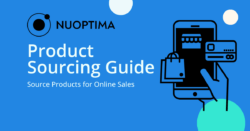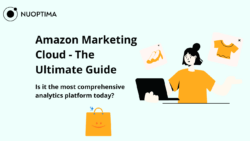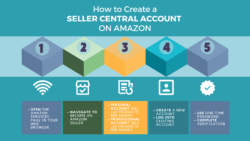Storing and selling as many goods as Amazon does requires a framework elaborated to keep track of all existing products. And this is the exact reason why Amazon’s American marketplace has implemented UPC codes into its strategy.
Each product sold on Amazon is granted a unique string of numbers known as a Unique Product Code, or Amazon UPC codes. These codes make it easier to categorize, find and sell products on Amazon. However, with so many possibilities available, how do you know where to look for UPC codes, and why do you need them in the first place? In this article, we will look into what these UPCs are, why they’re so important, how to use them and where to purchase them.
What are UPC Codes?
UPC (Unique Product Code) is a unique 12-digit code designed to identify retail goods. It is often complemented by a barcode that may be scanned for easier identification or inventory tracking within a warehouse and significantly expedites the checkout process. The barcode provides all relevant information on a product as well, such as the product’s name, size, brand, and colour. UPC is most commonly used in the United States, Canada, the United Kingdom, and Australia.
Needless to say, UPCs offer various advantages, including automation of the registration process. Imagine you no longer have to manually enter all product information. For small businesses, it might not make a huge difference, but for retail giants like Amazon, which consistently stores millions of products in their warehouses, it is crucial indeed.
When And Why Do Sellers Need UPC Codes for Amazon?
As a seller, you will have to acquire a UPC code for every item that doesn’t already have one. Normally this happens when you’re developing your own private label items and haven’t yet registered your brand with Amazon.
Since you are establishing a brand new product, a UPC has to be generated and issued specifically to it. For the product to be traceable, you’ll also need a scannable barcode. You can either use a UPC code or an Amazon barcode (ASIN, FNSKU, or MSKU).
If you want to conduct business on Amazon, it is necessary for you to acquire UPCs. Amazon requires a unique product identification, which the UPC code provides. Without it, you won’t be able to fill a tab called ‘Product ID’ when establishing a new listing, and you won’t certainly be allowed to sell on the platform, except for one case, which we’ll discuss in the next section.
Note that although it is necessary to have a UPC code to sell on Amazon, it is not required to attach the barcode to each of your products (unless you plan on using it yourself).
In Which Cases Do Sellers Not Need a UPC Code?
All products sold on Amazon.com must have a UPC number, with one exception. If you establish your own brand and register it with Amazon via their Brand Registry Program, you can qualify for a GTIN (Global Trade Item Numbers) exemption. Taking advantage of this option will allow you to upload your products without a UPC code.
Besides, just because your product doesn’t have a UPC number doesn’t mean you have to purchase one right away.
If you’re acquiring your goods from a wholesaler, dropshipping, or doing retail arbitrage, there is a great chance that your products will already have a scannable UPC number on their packaging. If that’s so, your goods are most likely in Amazon’s system already, and all you’ll have to take care of is adding existing numbers to the product ID field when creating an Amazon listing. To get the right UPC number, simply contact your supplier or the manufacturer.
Another scenario is if exactly the same product you’re offering is already available on Amazon, you won’t need to establish a new page to support it. All you have to do is choose ASIN (Amazon Standard Identification Number) option from the product ID dropdown list and enter the ASIN of an existing and active Amazon listing.
Other Types of Codes
Although those are namely UPCs that are widely recognized and that serve as the most popular identifying standard in the market, there are some great alternatives to them, such as ASIN, GTIN, EAN, and a few others. We’ll introduce you to some of them, and we’ll explain when can you take advantage of them:
-
European Article Number (EAN)
EAN code is the UPC’s European equivalent. If you are considering selling your goods on Amazon’s European or Indian marketplaces, you’ll need to use one of these instead of a UPC. In case you’ve already acquired a UPC code, you can always convert it to an EAN by simply adding a zero to the beginning of UPC. -
Japan Article Number (JAN)
JAN is the Japanese analogue to EAN and UPC. The difference between JAN and EAN codes is their beginning, they start with different digits, which helps to make them unique. -
Global Trade Item Number (GTIN)
GTIN is a 14-digit code that is recognized and used anywhere in the world. You can use them with both UPC and EAN barcodes. It is also possible for you to convert EAN into a GTIN. All you have to do is simply add a zero to the front of an EAN. -
International Standard Book Number (ISBN)
ISBN is a code intended to identify books all around the world. It is required for each published book to have one. Obviously, ISBN is not your responsibility unless you are the one selling books.
Before embarking on selling on Amazon, make sure you have acquired all of the required codes to avoid any problems that might occur while creating listings for your products.
A Little Preparation Before Purchasing UPCs For Amazon
There are a few things you should take care of before rushing to buy a bunch of UPCs.
-
Pick a pricing plan
The pricing plan doesn’t just limit itself to buying in bulk. GS1 provides a number of price options depending on the quantity of distinct you want to acquire. If your business is rather small and offers only a few goods, you can get a single UPC or GS1 US GTIN. However, those businesses that expect their product lines to expand in the near future might find the Company Prefix option more beneficial. Each code costs $30, and you don’t have to pay a renewal fee. Those sellers that need more than nine UPCs should instead choose the standard GS1 Company Prefix model, which is intended to assist them in managing a wider product range and expanding their business. This pricing plan includes the initial charge of $250, with a $50 annual renewal fee. With the next higher tier of 1 to 100 UPCs, the prices triple ($750 initial fee and $150 annual renewal fee). The key is to decide which pricing plan suits you the best. -
Determine how many UPCs you’ll need
Since buying in bulk is usually a lot more advantageous and gets you lower prices, take your time to calculate how many UPCs you want to purchase. Bundles need their own UPCs, just like separate products. Each size and colour combination requires a unique barcode. Don’t forget to calculate how many individual and bundled products you want to sell. -
Acquire the correct UPC
If you are both an online and offline merchant, your UPC requirements may differ from those of a solely online seller. For instance, if you have a physical store that sells the same products as your Amazon business, you can use the same GTIN for both. However, if these products are likewise being scanned in a warehouse or distribution centre, you’ll need separate codes for the same item.
How to Buy a UPC Code
Now you’re probably wondering how to acquire a UPC code for your goods. Turns out the process is actually rather straightforward.
However, before we get on with discussing how to buy UPC codes, let’s take a look at where to buy them.
First and foremost, you cannot generate code on your own. You have to acquire it through GS1, a non-profit organization charged with establishing standards for business communication and identifying retail goods around the world. There are more than100 GS1 organizations that serve various locations. For the United States, it is GS1 US, for example.
GS1 is considered the best spot to purchase Amazon UPC codes since it is the only provider Amazon acknowledges. They also use the GS1 database to check the authenticity of each and every one of the barcodes. Such precautions are taken to ensure that all codes are legitimate, and if any mismatch or misuse occurs, the listing will be rejected and withdrawn from the platform. Further action may later have a negative impact on the seller and his business. Therefore, it is critical to own a valid and active UPC for your goods. This is also the reason why we suggest getting all of your UPCs from GS1 or legitimate GS1 resellers.
Now let’s move to our initial question. Here is a catch-all guide explaining how to get a UPC code on the GS1 website:
-
Acquire a GS1 Company Prefix
GS1 сompany prefix is the part of your UPC code that identifies your business specifically. It might range from 6 to 10 digits, depending on how many UPC codes you need. The more of them you purchase, the shorter your business prefix will be, allowing you to fit more product numbers in.
A great number of business owners slip up and acquire this prefix from third-party sellers, who, for their part, purchased it in bulk to resell. And as we’ve already mentioned, it can gravely affect the credibility of your brand when Amazon discovers that your UPC does not match the one recorded in the GS1 database. -
Create Product Numbers
The type of product is identified by the numbers within your UPC codes. And once again, this number’s length is determined by the length of your company’s prefix. If your business prefix contains seven digits, your product numbers will include four digits (the 12th digit serves as the check digit). -
Choose your label design
Another thing you need to take care of is the deployment of your barcodes on your products. If you haven’t yet drafted the label and packaging for your goods, you can ask for a digital barcode and print it right on the labelling and packaging. However, in case you’ve already set your mind on the design of your packaging, you can simply get the barcode label stickers to stick on your goods.
If you’re subscribed for Fulfillment by Amazon (FBA), you have to physically attach the UPCs to the products. To fulfil this task, you’ll need to get yourself adhesive barcode labels, put the downloaded UPC pictures on them, and stick them on your goods. Ensure the barcode is in a visible and scannable location – the front and the back are particularly well suited, whereas the sides are not at all. - Obtain your barcodes!
What Is an FNSKU?
An FNSKU, or Fulfillment Network Stock Keeping Unit, is Amazon fulfilment’s unique number. If are you using FBA instead of delivering orders to the customers on your own, you will be required to attach an FNSKU barcode to all products sent to an Amazon fulfilment centre. An FNSKU is not necessary if you are not leveraging FBA.
When an Amazon fulfilment centre receives your package, they will scan the FNSKU barcodes to identify an Amazon seller who sent the shipment. To make the fulfilment process easier, Amazon requests sellers to attach this number to every product they ship. Since FNSKU helps Amazon to determine which seller to credit when a sale occurs, it is a very crucial part of the platform. It also enables Amazon to track each product back to the Seller of record in the case there is some quality issue and allows to prevent stock’s commingling.
If the products you’re selling have special packaging, you can place the FNSKU on the outside of the package so it will be easily accessible for a scan. If you didn’t provide the packaging for your item (for instance, a single t-shirt), the FNSKU could be attached to any tags on the product, including the size tag.
Where Can I get an FNSKU?
If you choose to print your shipping labels in Seller Central, FNSKU codes will be created automatically for your items, and each other product or its variation will get a different code.
At this point, you will have to decide whether it will be you or Amazon who will place the labels on the dropdown list. FNSKU labels may be applied to products individually, and if you haven’t yet had your packaging designed, you can create unique packaging with a place for FNSKU.
If, for some reason, you can’t attach the FNSKU labels yourself, Amazon may do it for you in exchange for a small charge. However, there are no fees for the FNSKU number itself.
Conclusions
UPC codes might be quite a perplexing matter for sellers, but once you put your finger on how they work and what their purpose is, getting codes for your products will be no problem at all.
When selling on Amazon, there’s a lot to consider, and acquiring UPC codes correctly is only one of many. However, with our company on your side, you can save yourself a lot of time and get things done right from the beginning. You no longer have to worry about developing a profitable business strategy on your own since we are at your side to help you find the most lucrative one that will assist in growing your business. Schedule a free discovery call with one of our professionals right now, or leave your email address, and we’ll get in touch with you as soon as possible.



